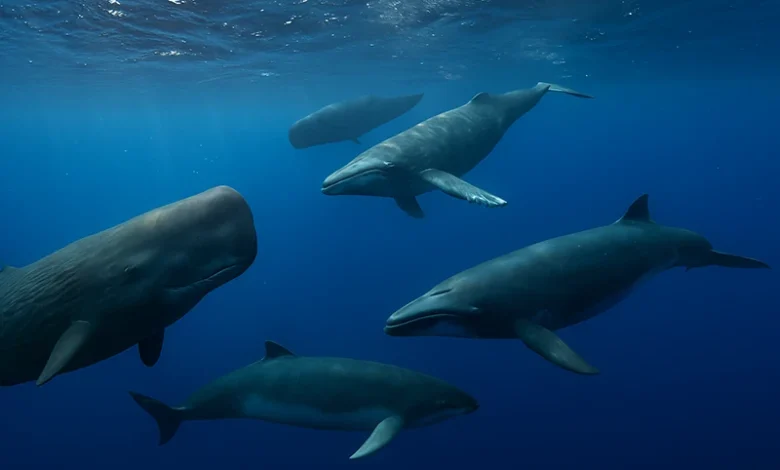Whales of Dominica: Species & Facts

The Whales of Dominica are among the island’s most mesmerising natural inhabitants, enriching the waters of the Caribbean Sea with life, movement, and ecological depth. With its steep underwater shelves, nutrient-rich currents, and protected habitats, Dominica is home year-round to the world’s most iconic deep-diving whale while also welcoming an impressive variety of migratory and seasonal species. These whales play vital roles in Dominica’s Marine Ecosystems, elevate its global reputation for Marine Tourism, and contribute to scientific understanding and the Dominica Economy.
Dominica’s Whale Species and Seasonal Visitors
A rich concentration of cetacean species defines Dominica’s offshore identity, with sightings often occurring close to shore. These range from resident populations to migratory giants who visit annually.
Sperm Whales
The most celebrated of Dominica’s whales is the Sperm Whale. This deep-diving leviathan makes Dominica the only country in the world where females and calves reside all year long. Favoring the deep waters off the island’s west coast, particularly near Soufrière, Scotts Head, and Layou, these whales live in tightly knit matrilineal groups. Their ability to dive to extreme depths—over 3,000 feet—for squid has fascinated researchers for decades.
The creation of the Sperm Whale Reserve in 2023 by the Government of Dominica was a groundbreaking act of marine stewardship. This protected area spans approximately 800 square kilometers and ensures the long-term safety of the whales from threats such as marine traffic, entanglement, and pollution. These whales’ unique social communication, known as “codas,” is currently being studied by the Dominica Sperm Whale Project and other scientific organizations.
Humpback Whales
From February to April, Humpback Whales migrate to Dominica’s warmer waters from the North Atlantic. They are known for their magnificent breaches and haunting underwater songs that echo through the sea. These acrobatic creatures, often seen alone or in pairs, use the waters of Dominica for mating and calving before returning north.
Short-Finned Pilot Whales and Others
Short-Finned Pilot Whales are frequently observed traveling in pods along the western coast. These sleek, dark cetaceans are highly social and often swim in tight, coordinated groups. Occasionally, Dominica also sees False Killer Whales, Pygmy Killer Whales, Killer Whales / Orca, Cuvier’s Beaked Whales, Gervais’ Beaked Whales, Melon-Headed Whales, Dwarf Sperm Whales, Blue Whales, Common Minke Whales, Sei Whales, and the elusive Pygmy Sperm Whales—each contributing to the diversity of the island’s Marine Biodiversity.
In rarer moments, Bryde’s Whales, baleen feeders who prefer warm, tropical seas, are spotted lunging through schools of fish near the surface, adding yet another layer of awe to the already rich marine landscape.
Whale Watching and Marine Tourism in Dominica
Experience the natural beauty of Dominica up close through whale watching – a deeply immersive activity that goes beyond the ordinary and places you directly within nature’s magnificent realm. With deep waters so close to the coastline, whales can often be seen just minutes after departure from ports like Portsmouth, Soufrière, and Roseau.
Tours operate under strict ethical guidelines aligned with Dominica’s commitment to eco-tourism and sustainable tourism. Operators must maintain safe distances, limit time spent near pods, and avoid disturbing the animals. These protocols are enforced by national bodies including the Ministry of Tourism, the Forestry, Wildlife and Parks Division, and the Discover Dominica Authority.
These encounters are a cornerstone of Dominica’s marine tourism, supporting jobs in coastal villages, generating income for local families, and strengthening the island’s reputation as the whale watching capital of the Caribbean.
Conservation, Threats, and Climate Realities
Efforts to protect whales in Dominica are comprehensive and growing in urgency. The island is on the frontline of balancing tourism with preservation, especially as climate change intensifies.
Whales here face threats familiar across the world’s oceans: marine debris, underwater noise pollution, collisions with vessels, and entanglement in fishing gear. These challenges are compounded by shifting prey availability as ocean temperatures rise, and acidification impacts the health of coral reefs and krill populations.
Collaborative work between government ministries and organizations such as the Caribbean Cetacean Society, The Nature Conservancy, and the International Whaling Commission supports ongoing monitoring and enforcement within marine reserves like the Soufrière Scotts Head Marine Reserve and the Cabrits National Park Marine Section.
Educational programs—especially within schools and fishing communities—emphasize the importance of whale conservation to both local livelihoods and the global climate.
The Role of Whales in Marine Ecosystems
Whales are not simply charismatic creatures; they are essential ecosystem engineers. Their feeding patterns and long journeys help distribute nutrients and fertilize phytoplankton, which supports local and global fish stocks and captures carbon dioxide. These unseen roles highlight the direct connection between whales and the critical issues of global food security and climate regulation, impacting even our island nation of Dominica.
Dominica’s Marine Reserves not only protect the animals but also secure the integrity of these essential ecological processes. The island’s coral reefs, seagrass meadows, and volcanic vents are all part of this interconnected system that supports everything from Diving Spots to sustainable fisheries.
By championing these efforts, Dominica positions itself not only as a destination for whale watching, snorkelling, swimming, and boating, but as a model for the Caribbean and the world on how marine protection fuels economic resilience.




